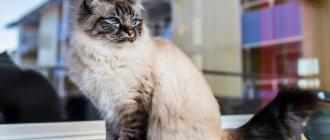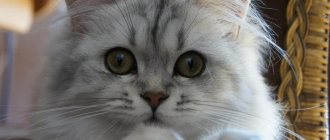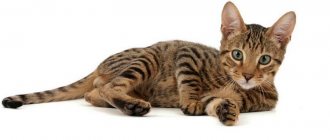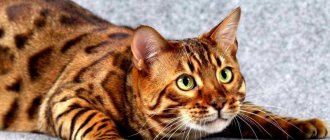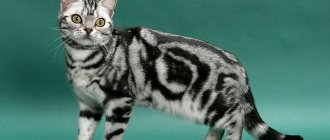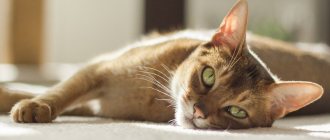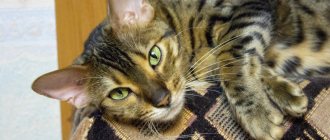Due to their character traits, Persian cats can be classified as homebodies who love to communicate with their owners. The animal is extremely affectionate and completely trusts the family members where it lives. At the same time, the pet is absolutely not annoying, does not raise its voice without special reasons, but simply waits for attention to be paid to it. Although they are often classified as animals that constantly spend time on the sofa, the furry beauties love to play and catch insects that fly into the apartment.
Red Persian cats: characteristics and care features
Persian cats, or Persians as they are often called, are representatives of one of the oldest and most popular breeds of long-haired cats.
It is not possible to find out their exact origin in our time. Many researchers of this issue believe that the ancestors of these cats actually lived in the territory of ancient Persia. Persian cats are also called Iranian - from the modern name of this country . These animals were brought to Russia in the late 80s from European countries by diplomats, where they gained the status of a very rare and expensive breed.
History of the breed
There are two versions of where and when the Persians appeared. According to one, Persian cats first appeared in Italy probably in the 17th century. One Italian merchant was making a long sea voyage and while in Persia he saw a uniquely beautiful cat that made him fall in love with her. The navigator brought the beauty to Italy for breeding, but what happened to her next is unknown.
After some time, Persians appeared in Paris, and after a while this breed spread throughout France. The Persians were liked by many aristocrats.
Soon, Cardinal Reshelier himself learned about the amazing cats, and he was quick to buy a Persian kitten for himself. He was one of the first to breed Persians in France. Also, this breed came to the court of the French king.
Then the Persians began to appear throughout Europe. In England, for the first time, they began to research the breed and breed Persian cats, developing new species and colors.
History of selection
According to felinologists, Persian cats descended from the wild manul cat and Asian desert representatives of the cat family.
At first, Persians had only black and blue coats, but as a result of selection, about a hundred different colors appeared: white, gray, red, lilac, color-point and many others.
In the 1970s, America was the country with the largest number of nurseries, but this had a negative impact on the formation of the breed - many animals with selection defects were exported to European countries. Only about 20 years ago, European breeders bred a healthy Persian cat and developed appropriate standards for this breed.
Breed standard
The World Cat Federation has prescribed the following standard of appearance for Persian cats.
- The squat, large or medium-sized body is supported by low, stable paws. The chest and shoulders should be broad and muscular.
- The thick coat, up to 12 centimeters long, is fine and silky. The neck, shoulders and chest have a collar-shaped coat of fur.
- The not very long fluffy tail is slightly rounded at the end.
- The head is round and massive, of good proportions, with a voluminous skull.
- The forehead should be prominent and the cheeks should be full.
- Persians have a short and wide, slightly snub nose with very open nostrils.
- Strongly built jaws and chin.
- The ears are small, set wide and low on the skull. They should be rounded at the ends, with beautifully growing tufts of hair.
- The eyes are large, very expressive, shiny, round and spaced far apart. Their color depends on the specific coat color (they can be blue, golden and even multi-colored).
- The coat can be either one color or consist of two or three shades.
- The weight of the animals varies from 3 to 7 kg.
Description of the breed
Persian standard
There are currently 4 main types of Persian cats recognized:
- The classic type (British) is outdated, with a noticeable nose, the edge of which is located 5-6 mm below the edge of the inner corner of the eye.
- Modern type (short nose) - have an open look, the bridge of the nose is raised. Thanks to the wide eyes, the nasolacrimal ducts are not deformed, and the animal does not have a gloomy expression on its face.
- Extreme type (American) - the breed description is characterized by a short nose, round forehead, low-set ears, and straight-set eyes. The earlobe is almost at the same level with the inner corner of the eyes.
- Pig type (piggy) - the convexity of the skull is almost not pronounced, low weight, weak bones. This type is derived from the extreme.
classical
modern
extreme
pig type
Regardless of the type, the following standard characteristics are distinguished:
- Body: massive but compact; the chest and stomach are wide, rounded; the tail is proportionally short, very fluffy; average weight for females is 3-4 kg, for males 5-6 kg.
- Coat: silky, soft long hair covering the entire body; There are more than 200 species of Persian cat colors, including the graceful white Persian chinchilla.
- Head: muzzle flattened, almost flat, bone wide; forehead is rounded; the nose is short and raised.
- Eyes: wide-set, large and expressive; eye color can be green, blue, brown, and can also differ from one another (colorpoints with blue eyes and chinchillas with green should be noted separately); friendly look.
- Ears: usually small, low set, rounded tips; hidden behind abundant fur.
- Limbs: paws are fluffy, thick, proportionally short relative to the body.
- Life expectancy: extreme Persians live up to 15 years, ordinary modern Persians under normal conditions can live on average up to 20 years.
Colors
- Solid (solid) - solid colors: white, black, blue, red (red), lilac, cream, chocolate. There are no patterns or streaks on the wool. Eye color is most often copper and dark orange or dark blue in white Persians.
- Bicolor is a combination of a primary color and white. The color of Persians is rare for Russian exhibitions, since breeding such a capricious spotted color requires a lot of effort. Bicolors should have at least 1/2 and no more than 2/3 white in color, with white spots on the head and tail desirable.
- Tabby - patterns on the fur: stripes, spots and marbles. Any basic coat color.
- Color point is the so-called Siamese coat color with dark spots on the face, paws and tail. Popular colors include brown, lilac, blue and black spots. Persian color-pointed cats were even identified as a separate breed - the Himalayan cat.
- Smoky is an amazing color in which each hair is conventionally divided into 2 color parts: a light base at the root and a dark color at the tip - tipping. At rest, the cat appears monochromatic, but when moving, the light undercoat becomes visible. Shades: black smoky, blue smoke, chocolate, tortoiseshell, lilac.
- Chinchilla - Golden and silver Persian chinchillas are now considered very popular and popular colors of the breed. Black tipping (the hair is colored only 1/8 with a dark tip) is evenly distributed on the back, sides, head and tail. The main color of gold is light apricot, while that of silver is pure white. A characteristic feature of chinchillas is the black rim around the eyes, nose and lips.
- Tortoiseshell is the color of Persian cats, in which there is a combination of two primary colors at once - red and black or their lightened analogues - cream and blue. This also includes the calico - a combination of tortoiseshell and white.
Red Persians
These cats have bright sunny red fur and often have beautiful honey-colored eyes.
By nature, red Persian cats are soft, affectionate, attached to the owner, whom they choose among all family members themselves.
But the calm disposition of these animals does not mean that they are not capable of strong emotions. Persians get very upset when they are left alone for a long time, without their owner, or if he pays little attention to them. These representatives of the cat family are very smart, quick-witted, and easy to train.
How to care?
If you become the owner of an adult Persian cat, then the following recommendations from experienced breeders will help you maintain his health and charming appearance.
- Hair and eye care. It is not difficult to guess that the main care is related to maintaining the healthy condition of the coat of Persian red cats. It needs to be thoroughly combed every day with special brushes and ensure that it does not fall off. Persians need to be bathed more often than cats of other breeds: approximately once every 2 weeks. The weak point of all cats of this breed is also the eyes.
To care for them and to prevent serious diseases, you should purchase a product from a pet store that needs to be used to wash your cat's eyes every morning.
- Correct diet. Adult Persian cats can be fed 3 times a day with both special super-premium food and natural food. The latter must necessarily include proteins (meat), offal, sea fish, cereals, cereals, and stewed vegetables. You can add a few drops of refined sunflower oil to your food; it improves digestion and the condition of the coat. It is forbidden to give cats sausage, spices, bones, pasta, and potatoes. Fish should be offered no more than twice a month, steamed and be sure to remove all bones.
- Typical diseases. Persian cats are prone to diseases such as cardiomyopathy, kidney disease, retinal atrophy, gingivitis, and they may have breathing problems. In addition, due to the ingestion of long hair during the licking process, hairballs form in their stomachs, to remove which special pastes or tablets are used. You should have regular checkups with your veterinarian and get all necessary vaccinations.
Health and diseases of the Persian cat
The Persian cat is in good health, but there are a number of diseases, the predisposition to which Persians are quite high.
Almost fifty percent of Persian cats are at risk of developing a very dangerous disease - polycystic kidney disease. The first symptoms of the onset of the disease can be considered loss of appetite, depressed state of the animal, and frequent urination. The appearance of these signs requires immediate contact with a veterinarian. In the absence of the necessary treatment, by the age of 7-9 years the cat is likely to develop kidney failure, which can lead to the death of the animal.
Hey let me in
A dangerous genetic disease is hypertrophic cardiomyopathy, which is symptomatically expressed in rapid heartbeat and periodic fainting. The difficulty of diagnosis lies in the fact that in 40% of cases these symptoms do not manifest themselves until sudden death occurs. Statistics show that cats are more likely to suffer from this disease than cats.
Retinal atrophy can cause a lot of trouble for your pet, which usually begins at an early age and progresses quickly - the kitten can become completely blind by the age of four months.
Teeth are another weak point of the Persian cat. Changes in the color of the enamel and an unpleasant odor from the mouth should be a reason for a visit to the clinic. The result of your carelessness can be the development of gingivitis (inflammation of the gums) and tooth loss.
Like all long-haired cats, Persians can develop skin diseases if not properly cared for. Do not forget to bathe your pet in a timely manner and comb its long hair daily with special soft brushes.
The special structure of the animal's muzzle caused increased tear production. The glandular ducts in the Persian cat are almost completely blocked, which causes tear fluid to leak out. Your furry “chronic crybaby” requires daily hygienic care for the eyes and muzzle.
Sleeping Persian
Almost all Persian cats wheeze or snore while sleeping. The reason for this is a shortened nasal septum. It is almost impossible to correct the defect. All that remains is to treat him as a cute flaw. Moreover, this does not affect the general condition of the animal in any way.
This breed does not like to bathe very much, but they need to be bathed more often.
While often licking themselves, neat Persians swallow some of the fur, and it accumulates in the stomach. To avoid health problems, you should give your cat special tablets or paste that will help get rid of hairballs painlessly.
Practice shows that with proper care, timely vaccination, and professional veterinary care if necessary, it is possible to significantly reduce the risks of various diseases or alleviate their course.
With good owners, a Persian cat is quite capable of living happily for about 15-17 years, and some live up to 20 years.
Home keeping kittens
Persian red kittens are very attractive and look like fluffy bear cubs with huge eyes. Purchase in advance everything you need for this cute baby: food bowls, a scratching post, brushes for combing wool, bathing products, a tray, a bed, toys. Kittens of this breed are very inquisitive, affectionate and trusting; they follow their owner everywhere. Persian babies are clean and quickly get used to the litter box.
Up to 6 months, kittens should be given warm milk mixed with cottage cheese, a boiled egg, boiled chicken meat, a little raw beef, milk porridge (but not often). Dry food is introduced no earlier than the kitten is 3 months old.
Red Persian cats are charming, sociable and completely non-aggressive creatures. They easily get along with any family member and are friendly towards other pets. It is also believed that red Persians attract financial well-being to the home.
For general information about the Persian cat breed, see below.
Character and behavior
A Persian cat, like any other, once in a family, looks for a leader, a dominant, to whom it will obey for the rest of its life. Representatives of this breed themselves do not know how to be a leader, but they also do not want to remain at the bottom rung of the family hierarchy - they occupy the middle, where they feel quite comfortable. Accordingly, the Persians obey one person, and simply bestow their attention on the rest.
It is believed that males more often choose a woman as an owner, and cats - a man.
A smart and intelligent cat does not like fuss and is never in a hurry. This is a true phlegmatic: slow, thoughtful, with smooth movements - as they say, “on his own mind.” The little Persian doesn’t mind chasing a ball around the rooms, jumping on chairs and tables, playing tag, but as he gets older, he will prefer more interesting pastimes. As one well-known aphorism says, if you communicate with a kitten as with an adult, and with an adult as with a rational being, your Persian will not be inferior in intelligence even to a German shepherd.
Many Persian owners claim that the cat understands them literally. What they prefer most is communication with family members. If you talk to her often and affectionately, your kitty will understand that she is needed and loved. This breed is not suitable for fussy, active and active people.
Persians do not really like to sit on their hands, preferring to receive their portion of affection by sitting down at a distance. Inactive, meows rarely, loves to lie on the window for a long time and watch what is happening on the other side of the glass. But he is afraid to walk down the street. He communicates calmly with all pets: be it a dog, another cat, a parrot or a small rodent. Unfortunately, there are no Persian hunters.
They treat strangers with distrust. They are loyal to children, but do not tolerate being pulled by the tail. They value comfort and coziness: having chosen a cozy sofa or armchair for themselves, they will be extremely unhappy if someone else encroaches on it.
Mother cats are very caring and, curiously, show absolutely no aggression towards others who want to take a closer look at the babies or pick them up.
How did the cat move in K.I. Chukovsky’s famous poem “The Cockroach”?
jump backwards
Persians are vulnerable and touchy. You cannot raise your voice or raise your hand at them.
Expert opinion
Dusheba Vera Ivanovna
In 2010, she graduated from the Moscow State Academy of Veterinary Medicine named after K.I. Scriabin with honors, specializing in veterinary medicine. I regularly attend veterinary conferences, congresses, and webinars.
Persians are not carried by the withers, only with emphasis on the paws.
Persian cat - features and photos of red and white kittens
Due to their character traits, Persian cats can be classified as homebodies who love to communicate with their owners. The animal is extremely affectionate and completely trusts the family members where it lives. At the same time, the pet is absolutely not annoying, does not raise its voice without special reasons, but simply waits for attention to be paid to it. Although they are often classified as animals that constantly spend time on the sofa, the furry beauties love to play and catch insects that fly into the apartment.
Care and maintenance
An important characteristic of the breed is its high adaptability. Phlegmatic Persian cats easily get used to any conditions. Therefore, they will be equally comfortable in a spacious mansion and in a small apartment. Caring for representatives of the breed comes down to proper nutrition and hygiene procedures.
The luxurious fur of the Persian cat is prone to matting. To avoid this trouble, the animal is combed daily with a comb with sparse rounded teeth and a brush made of natural bristles.
On a note. You cannot use a slicker brush to comb out Persians. It injures the undercoat, which then takes a long time to recover.
They bathe their furry pet on average 3-4 times a year. Moreover, a black Persian cat is washed less often than a white one. Shampoos and conditioners for long-haired animals are suitable for bathing. Wash the cat in a warm room where there are no drafts, and after bathing procedures, the pet’s coat is completely dried and combed.
The Persian's ears are regularly inspected for any unusual discharge and wiped with a moistened cotton pad.
The cat's teeth are brushed weekly with a silicone brush with a small amount of special paste for animals.
Due to the anatomical features of the Persian, there is constant tearing. Therefore, a cat of this breed requires systematic eye care. They are wiped daily with a cotton pad moistened with boiled water.
The claws of a Persian cat are shortened with a nail clipper as they grow. This is done very carefully so as not to injure living tissue.
Important! Persians are very neat cats and often groom themselves. To prevent the Persian cleanliness' gastrointestinal tract from becoming clogged with hairballs, the animal is regularly given a special paste.
Interesting facts from the history of the animal
The cat came to Europe back in the 16th century thanks to the famous traveler Pietro della Valle , who bought the animal in the Persian province of Khorasan. At the same time, the cat was similar to its modern relatives only in its long coat. Due to the fact that the breed was considered exotic in those days, only wealthy merchants and other members of the nobility could buy it.
The lion's share of the work in the selection of modern representatives of Persian cats was done by America. Thanks to the efforts of American breeders, the cat's fur lengthened and its nose became flattened, which turned into a real problem for the animal's respiratory system.
The breed became a trend thanks to Queen Victoria, who kept more than a dozen Persian cats with a blue color. She even ordered the construction of a special castle for pets. So, the Persian cat, as in the photo, turned into the most desired animal among the aristocracy of Europe.
Colors
In nature, there are many colors of Persian cats. They come in both single color and multicolor.
Let's look at the most common ones:
- White peaches are amazing in their beauty; such peaches require special care.
- Grays are the most common, they come in both gray-pebble color and smoky, gray-blue.
- Black - despite the fact that they are not often found, they are not in particular demand.
- Redheads are very pretty, affectionate sissies.
- Blue ones are unusually beautiful, somehow majestic. Queen Victoria of England herself had a blue Persian cat.
- Cream - born from Persian cats with a weakened gene responsible for the color of the future generation. At the same time, these kittens are very cute.
- Purple peaches are very rare animals, they can rarely be found even in nurseries; to see them with your own eyes, you need to go to an exhibition.
- Red - or orange-red, one of the most ancient types of Persian cats.
- Two-color - there are a lot of options and combinations.
- Tabbies are tortoiseshell or brindle, with a specific pattern all over their body.
- Chinchillas are extraordinary animals, but they are not very easy to buy, nor are they cheap.
Features of the Persian cat breed
The Persian cat can easily be considered one of the most beautiful and popular breeds in the whole world. Most Persians are sweet, magical creatures that turn into true friends and family favorites. Moreover, this happens not because of the external attractiveness of the furry pet, but due to the unique character traits that make a person fall in love with him at first sight.
The Persian cat breed is characterized by a miniature, wide and slightly snub nose. The breed also has short but powerful legs. The Persian cat breed standard implies that the animal has the following distinctive features:
- round and massive head, proportional to the structure of the body;
- short but wide neck;
- large or medium massive body;
- low, wide cheekbones and round, full cheeks;
- shortened snub nose;
- low-set miniature ears, rounded at the ends;
- round eyes always wide open;
- powerful shortened paws;
- thick but short tail slightly rounded at the end.
Due to the variety of cat colors, breeders subdivide the breed into more than a hundred subspecies . You can meet a black, gray, white, blue, cream, red, red and even purple cat. At the same time, a white cat may have dark orange, copper, green or blue eyes. But in most cases, the color of the coat corresponds to a certain shade of the eyes. If the animal has a single color coat, then no stripes or spots should be present. In general, the standards of Persian cats have a huge number of coat shades, which directly affect the cost of kittens.
Character traits inherent in the breed
According to the stories of owners of Persian pets, keeping a cat at home is a lot of fun. This is a playful representative of the cat family who loves his owner immensely. In addition, the breed has the following character traits:
- Persians have soft character traits and a very pleasant voice, which the cat practically never uses;
- the Persian constantly demands love and attention from his owners, repaying the same in return;
- the breed is gentle and pampered, although undemanding compared to other representatives of cats;
- the cat remains devoted to its owner until the end of its life, not forgetting to show its status.
Features of caring for a pet
The Persian cat can be classified as one of the most demanding animals in terms of care. Due to the very long and thick coat, it is important to take good care of your pet every day. Otherwise, the wool rolls down and balls form. Every person who decides to have a Persian at home should have metal combs with teeth of different lengths, as well as brushes with different degrees of bristiness in their arsenal. You will also need a whole arsenal of cosmetics: shampoos, conditioners and, of course, talc.
In addition, the cat suffers from regular eye discharge and breathing problems, so it is important to clean the eyes from time to time . Having decided to have a fluffy Persian cat at home, it is important to be prepared to constantly care for the fur, bathe the animal, and also clean the eyes and ears. Only by giving care and love to an animal can you receive affection and devotion in return.
Care
The Persian cat can rightfully be called one of the most demanding of attention and care. What requires most attention is a chic fur coat and a balanced diet.
Wool
The most important thing in caring for a Persian cat is to understand that he will need daily care. This long, beautiful coat by itself cannot remain clean and tangled: tangles of the undercoat can form very quickly, which causes great inconvenience to the animal, and it is very difficult to comb them out.
The pet must be gently but thoroughly combed every day, first soothing it with smooth strokes, and then carefully combing it with a special long-toothed brush according to the hair growth. At the end of the procedure, you need to use a spray with an antistatic effect.
Advice! A good purchase would be a furminator - a special comb-trimmer with frequent metal teeth, which will ease the spring-autumn periods of shedding in Persians.
Bathing is not the most favorite procedure for cats, so the optimal frequency is once a month. After washing to dry, it is better to use a hairdryer on low power to avoid drafts and the likelihood of a runny nose and colds.
How to cut a Persian's hair is a very popular request; however, cats do not require a specialized haircut, but sometimes matted fur needs to be cut off. Grooming Persians can be a solution for owners and pets who live in hot and humid climates. For the summer period, the hair from the body is cut off, without affecting the head, tip of the tail and toes.
It is important to keep the litter box clean as droppings and litter pellets can get stuck in paws or on thick fur. If you don't clean it out scrupulously, the Persian may become stubborn and start shitting in the wrong place. Some Persian owners prefer to slightly shorten the hair between the toes, which reduces the problem.
Nutrition of Persian cats
Persians often have problems with the digestive tract, so their nutrition must be approached with particular seriousness.
The basis of their natural diet should consist of lean meat, which is given boiled, baked in the oven or even raw. Several times a week you can add organ meats or fish. In addition, cats also receive vegetables, most often boiled carrots, cauliflower or broccoli, zucchini and pumpkin. Be sure to add low-fat fermented milk products (yogurt, kefir, cottage cheese) to your animal’s diet.
If you decide to feed your cat natural food, then you need to additionally add age-appropriate vitamins and taurine to the diet.
Important! As an alternative, you can use ready-made food, but it is not recommended to choose manufacturers from the economy segment. What you feed your cat determines its lifespan.
Many experts believe that cats after castration are less active, eat more and begin to gain weight, but this is not entirely true. If you correctly calculate the daily ration and prepare a diet with a limited fat content, and also keep your cat busy with active games, then weight gain will not occur.
Advice! Buy stable, wide, but not very deep bowls for water and food so that your Persian is less likely to stain the hair on his face while eating.
Dry food for Persians
The Persian breed is so popular and numerous that special food is produced for Persians to maintain the beauty of the coat and its easy removal from the intestines. Popular brands:
- Royal Canin Adult Persian is a specialized food for Persians from Royal Canin.
- Pro Plan Optiderma Elegant – for healthy skin and coat.
- Grandorf Cat Indoor will not only help maintain the beauty of the coat, but will also reduce allergic reactions in cats with sensitive digestion.
- Orijen Cat 6 Fresh Fish - small granules of food are perfect for Persians with extreme stops, so cats will not need to open their mouths too much when eating. Origin belongs to the holistic class.
Caring for ears, eyes and claws
The ears should be cleaned with a cotton swab soaked in a special lotion once a week.
Since the eyes of Persian cats have specific tear ducts, they regularly secrete secretions, which is why the eyes often water. It is difficult to remove discharge without causing inconvenience to the cat, so dried crusts should be wiped with a cloth and eye care product.
Regular nail trimming is necessary for the animal; you can do this yourself using a nail clipper: you need to carefully cut off only the tip of the claw to avoid injury to the vessel inside.
Walking your pet
Persian cats are rarely taken for walks: they are calm in nature and do not want to go on a trip. It is enough for them to be in the space of the apartment, and they can watch everything that happens from an open window.
If the owner has a private house and prefers to let the cat outside, then experts recommend fencing off a section of the garden for him where he could spend time, but even in such conditions he must be constantly monitored. And don’t forget to treat your cats for ticks and worms, and for the summer, you can purchase a collar impregnated with an anti-parasite agent.
How to choose the right kittens?
When choosing a Persian kitten, it is important to pay attention to how playful and active he is. A healthy animal does not sit still for long, and its coat is shiny. The kitten's belly should be soft to the touch, and no unpleasant odors should be emitted from the mouth. When buying an animal, it is important to ask the breeder for all the accompanying documentation and see in what conditions the Persian kitten was kept.
It is advisable to buy an animal at two months of age , when the kitten can feed itself and its body is fully formed. If a person decides to get a pet for the purpose of breeding, then it is better to buy the animal from a nursery at the age of 4 months, when any defects, if the kittens have any, can be easily identified. Photos of Persian predators will also help you decide on the choice of a red or white furry pet.
The times when the purchase of a Persian cat was available only to wealthy sultans or other nobility have long since sunk into centuries. If a person is fascinated by this cute and beautiful animal, then there is no need to doubt and boldly go to the nursery to acquire a faithful and devoted friend for the whole family.
How to choose a Persian kitten
First of all, you should pay attention to the purpose of the choice - if you want to participate in exhibitions, then the mother cat must be selected from a special club with a mandatory ideal pedigree and the cost will be correspondingly high. If the kitten is for home and for your soul, then you need to find out from the breeder about the type of breed, the health of the offspring, and the presence of diseases in its parents.
Advice! The breed type appears in the baby at about 2-4 months, this is the optimal time for choosing.
It is advisable to take the kitten out of its familiar environment so that you can assess its contact with other animals, find out whether it feeds itself and whether it is potty trained. A healthy kitten should show interest in everything around it, including you. He should be clean and his coat should be smooth.
The price of kittens varies depending on the type of cat and color; eye color is also important. The most expensive colors will be golden and silver chinchillas, solid (snow white, black), smoke and tortoiseshell calicos. On average, breeders offer to buy a two-month-old kitten for 5 – 15 thousand rubles.
blue kitten persian
gray bicolor
Basic moments
- The Persian cat is exclusively a domestic animal in the literal sense of this definition. Representatives of this breed have lost the ability to hunt; they cannot run fast or make high jumps. Your pet will not need walks outside.
- Persians love to lie down for a long time. Such inactivity is typical for all representatives of the breed and is not a sign of any physical ailment.
- Persian cats are very calm and do not need large spaces. They will never bother you with their activity and get under your feet. For the same reason, you won’t have to be upset about torn curtains and damaged upholstery of upholstered furniture.
- Persians are very affectionate and do not like to be alone. They will even prefer to sleep in bed with you and it is difficult to wean them from this.
- The animal’s kind, easy-going disposition allows even the smallest children to be left alone with it without fear.
- Owners of Persian cats note their high intelligence. They are well trained, follow simple commands, and quickly get used to the litter box.
- The Persian will rarely draw attention to his problems by meowing. In most cases, he will simply come to the owner and begin to look at him intently, as if trying to mentally convey to you the essence of his request.
- Due to their balanced character, these “sofa” cats easily find a common language with other pets and peacefully share their living space with them.
- The Persian cat will treat all household members peacefully and calmly; some wariness may appear only when a stranger appears, but this will not last long.
- The attractive appearance of the animal makes most people want to take a cat in their arms. If she resists, never insist. The Persian does not like violence and can hold a grudge for a long time.
- Persian cats have a tendency to overeat. They often beg in an effort to get a tidbit from their owner. If you do not accustom your pet to a certain diet and indulge his gastronomic desires, then health problems due to obesity will not take long to occur.
Character of the Persians
The obedient Persian is known for being quiet and sweet most of the time. They are affectionate and picky, they give all their attention to their owner, but at the same time they are wary of house guests.
Important! Persian cats make excellent companions for their owner's family - they are calm and do not fuss unreasonably.
The Persian cat's personality is very calm; loud environments are frowned upon. Their usual needs and activities include eating, playing with toys, and napping during the day. And the most important thing for them is a lot of love, which a caring owner will be able to give to her by carefully combing her fur.
Such cats are unlikely to jump on your curtains or chew your wallpaper. While the family is not at home, the quiet cat prefers to be the decoration of the chair, waiting for his evening portion of care.

